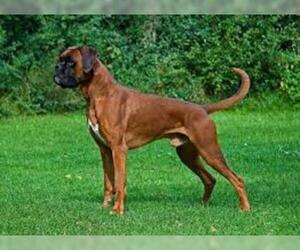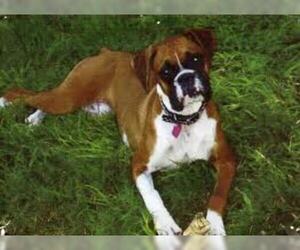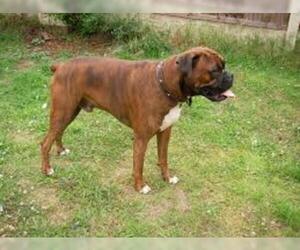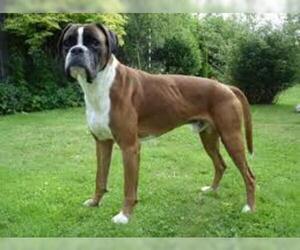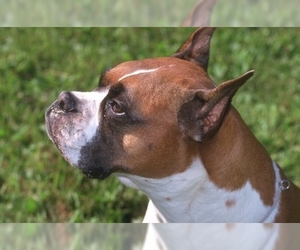
All about Boxer dog breed
A.K.A. :Deutscher Boxer, German Boxer, Dutch Boxer, Boxer dog, Boxy, Boxerman
Size
Grooming requirements
Exercise requirements
Good with other dogs
Watchdog ability
Energetic
Training requirements
Playful
Affectionate
Good with other pets
Good with children
Good with strangers
Winter
Summer
Healthiness
Protective
Life Span
| Pure Breeds | Member |
| Breeds A - Z | B |
| Breeds by Group | Working |
| Breeds by Trait | Good With Kids High Stamina Dog Breeds Smartest Dog Breeds |
| Overview: | The Boxer is a medium-sized, short-haired dog breed of German origin, known for its distinctive appearance and vibrant personality. Physically, Boxers possess a strong, athletic build with a characteristic square head, an undershot jaw, and often a docked tail and cropped ears (though these practices are becoming less common). Their short, glossy coat typically comes in fawn or brindle, often with white markings. Temperamentally, Boxers are renowned for being incredibly loyal, intelligent, and energetic, making them fantastic companions for active families. They thrive on human interaction and can be playful and patient with children, making them excellent family pets. While their energy levels require regular exercise, their adaptability means they can adjust to apartment living if their activity needs are consistently met. However, potential owners should be aware of certain health considerations, including a predisposition to some cancers, heart conditions like cardiomyopathy, and hip dysplasia, underscoring the importance of responsible breeding and regular veterinary check-ups. |
F.A.Q.
All You Need to Know About the Boxer Breed
The Boxer is a magnificent, medium-sized breed originating in Germany, renowned for its loyal and playful temperament. These dogs are incredibly energetic, intelligent, and form strong bonds with their families, making them excellent companions for active households. Physically, Boxers boast a muscular build, a distinctive short snout, and a typically cropped tail (though natural tails are increasingly common). Their short coat requires minimal grooming, perhaps a weekly brush, but their high energy demands daily exercise and mental stimulation to prevent boredom. While adaptable, their need for activity means they are better suited to homes with yards, though dedicated owners can make apartment living work with sufficient outings. Potential owners should be aware of common Boxer health issues like certain cancers, heart conditions, and hip dysplasia. Choosing a reputable breeder is crucial for a healthy, well-socialized Boxer puppy.Boxer Weight: The average weight for an adult Boxer is between 55-75 pounds. Males typically weigh more, ranging from 65-75 pounds, while females generally fall between 55-65 pounds. Maintaining a healthy weight for your Boxer is crucial for their well-being.
Curious about Boxer height or how tall is a Boxer? You've come to the right place! We often get questions about their average size, and it's an important factor when considering this magnificent breed.
The average height of a Boxer adult, measured at the shoulder, typically ranges between 21 to 25 inches.- Males: Generally, male Boxers tend to be on the taller side, typically ranging from 22 to 25 inches at the shoulder.
- Females: Female Boxers are usually a bit smaller, with their average height falling between 21 to 23.5 inches at the shoulder.
The Boxer colors officially recognized by major kennel clubs like the AKC and UKC are Fawn and Brindle. Fawn Boxer colors range from a light tan to a deep mahogany. Brindle Boxer colors feature black stripes on a fawn background, with variations from light to heavy brindling.White Boxers are also common, making up about 25% of the breed. While healthy and genetically purebred, they are considered a fawn or brindle Boxer with extreme white markings and are often disqualified from conformation shows, though perfectly acceptable as companions.Rare Boxer colors and exotic Boxer variations exist but are not accepted by the AKC. These include Blue Boxers, Lilac Boxers, Chocolate Boxers, and Merle Boxers. These coat types often indicate mixed breeding, a rare genetic mutation, or may be associated with health issues, and are not considered standard for the breed. Be cautious when encountering breeders marketing these as "rare" purebred Boxers, as they are not AKC recognized Boxer colors. Pricing for these rare coat types can be significantly higher, but they do not meet breed standards.
The Boxer personality is renowned for its friendly, loyal, and playful nature. They are deeply devoted to their families, often forming strong bonds with a preference for human companionship. This makes them highly sociable dogs, thriving on interaction and attention.Regarding temperament of Boxer with children, they are generally excellent, known for their patience and protective instincts. However, their boisterous energy means supervision is always advised, especially with very young children, to prevent accidental knocks during enthusiastic play. With other pets, early socialization is key. While many Boxers can coexist peacefully, especially if raised together, some may display a strong prey drive towards smaller animals or be assertive with other dogs, particularly those of the same sex.While adaptable, Boxers are not ideal for apartment living unless owners are committed to providing ample daily exercise and mental stimulation. They are energetic dogs that require regular physical activity to prevent boredom and destructive behaviors. Left alone for extended periods without engagement, their playful energy can manifest as chewing or digging. Overall, the Boxer is a loving, energetic, and highly trainable breed that thrives in an active household where they are an integral part of the family.
Boxer Temperament & PersonalityThe Boxer temperament is renowned for its delightful blend of playfulness and unwavering loyalty, making them exceptional companion dogs. They are highly affectionate, incredibly friendly, and possess a joyful, clown-like demeanor that brings much laughter to their families. Boxers are generally very sociable and thrive on human interaction, eager to be involved in all family activities.Their loyalty to their owners is profound, often displaying a protective instinct without being overly aggressive. When it comes to children, Boxers typically excel, being patient and playful companions, though their boisterous nature means supervision is always wise, especially with very young children. Their behavior with other pets can vary; early socialization is key to fostering harmonious relationships, but many Boxers coexist happily with other animals.While intelligent and eager to please, Boxers can exhibit a stubborn streak, requiring consistent and positive reinforcement training. They are also quite sensitive and do not respond well to harsh correction, preferring gentle guidance. Regarding apartment living, Boxers are adaptable if they receive ample daily exercise and mental stimulation. They are energetic and require regular walks, playtime, and a securely fenced yard is a bonus for their exuberant bursts of energy. Ultimately, a Boxer is a devoted, lively, and loving family member.
Boxer Care: Daily Maintenance & Health Tips
Caring for a Boxer involves consistent routines to ensure their well-being. This breed, while playful, has specific needs. Here's how to care for a Boxer:Grooming Needs: Boxers have short, low-maintenance coats. Weekly brushing with a rubber curry brush or a soft bristle brush is usually sufficient to remove loose hair and keep their coat shiny. Occasional baths, as needed (typically every 1-2 months), will keep them clean without drying out their skin. Nail trimming every 2-4 weeks is essential to prevent discomfort and paw issues.Exercise: Despite their energetic bursts, Boxers are not considered a high-endurance breed. They require moderate daily exercise – at least 60-90 minutes, ideally split into two or three sessions. This can include brisk walks, playtime in a securely fenced yard, or short training sessions. Avoid strenuous activity during the hottest parts of the day due to their brachycephalic (short-nosed) anatomy. They are not suited for long-distance running or extreme heat.Dietary Considerations: A high-quality dog food formulated for medium to large breeds is recommended. Portion control is crucial to prevent obesity. Consult your veterinarian for specific dietary recommendations based on your Boxer's age, activity level, and any underlying health conditions. Feeding two smaller meals a day instead of one large meal can help prevent bloat, a serious condition common in deep-chested breeds.Wrinkle & Ear Cleaning: Boxers have facial wrinkles that can trap moisture and debris, leading to skin irritation or infections. Clean their facial folds daily or every few days with a damp cloth or a veterinarian-approved wipe, ensuring they are thoroughly dried afterward. Their ears should be checked weekly for redness, odor, or excessive wax, and cleaned gently with a vet-recommended ear cleaner if needed.Climate Sensitivity: Due to their brachycephalic anatomy, Boxers are highly sensitive to extreme temperatures. They can overheat quickly in hot, humid weather and are also susceptible to respiratory issues in very cold conditions. Keep them indoors during hot weather, provide plenty of fresh water, and avoid strenuous exercise. In cold weather, ensure they have a warm, sheltered place to rest.Common Health Concerns: Boxers are prone to certain health issues. Skin issues can include allergies and infections in their wrinkles. Regular cleaning helps prevent these. Dental care is vital; daily brushing is ideal to prevent plaque buildup, gum disease, and tooth decay. Weight management is key to preventing conditions like arthritis and heart disease. Other common concerns include certain cancers, heart conditions (like Boxer cardiomyopathy), and hip dysplasia. Regular veterinary check-ups are essential for early detection and management of these conditions.The Boxer is a breed with a moderate to high activity level, known for their enthusiastic and playful nature. They are generally energetic dogs that require consistent physical and mental stimulation to thrive. Understanding the Boxer activity level is crucial for prospective owners.
Typical Energy Levels: Boxers are recognized for their bursts of energy, often zooming around with great speed and agility. However, these intense periods are typically followed by long stretches of rest and relaxation, during which they enjoy lounging with their families. They are not dogs that are constantly "on the go," but when they are active, they are very active.Daily Exercise Needs: To meet their Boxer exercise needs, they require at least 60-90 minutes of dedicated physical activity per day. This can be broken into multiple sessions. Good activities include brisk walks, jogging (for adult Boxers on soft surfaces), interactive playtime in a secure yard, or engaging in dog sports like agility or obedience training. Mental stimulation is also vital, so puzzle toys and training sessions are beneficial.Playtime Preferences: Boxers love to play! They are known for their boisterous and silly antics, enjoying games of fetch, tug-of-war, and chasing toys. They thrive on interaction with their human family members and often initiate playtime themselves. They are excellent companions for children who understand how to interact respectfully with a large, playful dog.Limitations due to Brachycephalic Anatomy: Due to their brachycephalic (short-nosed) anatomy, Boxers are prone to overheating. This is a critical consideration for their exercise routine. Strenuous activity should be avoided during hot and humid weather, and exercise sessions should be scheduled for cooler parts of the day (early morning or late evening). They should always have access to fresh water, and owners must be vigilant for signs of heatstroke. Activities that involve excessive panting or breathing difficulties should be immediately ceased. This means they are not ideal long-distance running partners, especially in challenging conditions.Suitability for Households: Boxers are best suited for active families or individuals who can commit to providing their significant exercise requirements and engaging with their playful personalities. While they balance short bursts of energy with long periods of rest, they are definitely not a breed for low-energy households looking for a sedentary companion. A bored Boxer can become destructive, so consistent exercise and mental engagement are key to a well-behaved and happy dog. Owners frequently ask, "how active are Boxer?" and the answer is that they are very active when they need to be, but also excellent cuddle buddies when playtime is over.Breed Breakdown: What Experts Say About the Boxer
I would rate the "Size" trait of the Boxer breed at a 7.Boxers are definitively a medium-to-large sized dog breed. They are not giant breeds like a Great Dane or Irish Wolfhound, nor are they toy or small breeds like a Chihuahua or a Cavalier King Charles Spaniel. Averaging 21-25 inches in height and weighing between 50-80 pounds, they possess a muscular, athletic, and substantial body structure. When compared to the vast spectrum of companion dogs, they fall into the larger half.While their loyal and adaptable nature might make them *personally* suited for an apartment, their physical size and high energy levels mean they are not ideally suited for apartment living without significant and consistent outdoor exercise. Their powerful build requires space to move and burn off energy. They can travel, but their size makes them too large for most in-cabin pet policies on airlines, requiring them to travel in cargo which can be stressful. Households with significant space constraints, such as small apartments without a yard, would likely struggle to adequately meet a Boxer's needs. They truly thrive in homes with a yard or owners committed to frequent, vigorous outdoor activities.
I would rate the Boxer's grooming requirements as a 3 out of 10.Boxers are generally considered low-maintenance in the grooming department. Their short, smooth, single coat sheds moderately, but it doesn't require complex brushing – a weekly once-over with a rubber curry brush or grooming mitt is usually sufficient to remove loose hair and keep their coat shiny. While they do have a few wrinkles, particularly around their muzzle, these are typically not as deep or extensive as some other brachycephalic breeds, making skin fold care relatively straightforward with just regular wiping to prevent moisture buildup. Ear cleaning is standard for any dog, needing a check and wipe weekly, and nail trimming every few weeks is also routine. They don't require frequent bathing, usually only when they get visibly dirty or every few months to keep their skin healthy. While they can be susceptible to some skin issues or allergies, this isn't a guaranteed aspect of their grooming and, when it does occur, often requires veterinary intervention rather than specialized grooming techniques. Compared to breeds with long, thick, or double coats, or those with very deep wrinkles or extensive furnishings, the Boxer is a very easy breed to care for from a grooming perspective, making them a good choice for owners who prefer minimal fuss.
I would rate the Boxer's "Exercise Requirements" a 7 out of 10.While Boxers are renowned for their playful, high-energy personalities, their exercise needs are more nuanced than a pure endurance breed. They thrive on regular, structured activity but are not built for extreme, sustained exertion. Daily exercise is crucial for both their physical health and mental well-being, as a bored Boxer can quickly become a destructive one. They benefit from at least 60-90 minutes of vigorous activity spread throughout the day, which could include brisk walks, enthusiastic playtime in a securely fenced yard, or even short bursts of fetch or tug-of-war. They are intelligent and enjoy learning, making them good candidates for dog sports like obedience or agility, but these activities should be approached with an understanding of their limitations. Their brachycephalic (short-nosed) anatomy makes them highly susceptible to overheating and respiratory distress, especially in warm weather or during intense, prolonged exercise. Therefore, activity needs to be carefully monitored, and strenuous outdoor exercise should be avoided during peak heat. While they have bursts of incredible speed and power, they aren't marathon runners. They require structured routines to stay healthy and mentally stimulated, and while they enjoy downtime with their families, simply "chilling" all day won't suffice for a Boxer to truly thrive. They need that outlet for their inherent energy and playful nature.
I would rate the Boxer's "Watchdog Ability" at a 7 out of 10.Boxers are generally very alert and aware of their surroundings. They are quick to notice unfamiliar sounds or people approaching their territory. Their barking behavior can be quite effective; while not excessively "yappy," they possess a deep, authoritative bark that projects a sense of alarm and can certainly deter an unfamiliar presence. They have strong territorial instincts when it comes to their home and family, and will typically position themselves between their loved ones and a perceived threat. When faced with an intruder, a Boxer is likely to respond with a combination of barking, assertive posturing, and a general willingness to deter, often relying on their imposing size and vocalizations. They are not passive companions in the face of a potential threat; they are very capable of providing meaningful early warnings and acting as a physical deterrent in a home environment. However, their generally friendly and social nature means they might eventually warm up to a *non-threatening* stranger once their owners have accepted them, which is why they don't quite reach the 9 or 10 status of breeds specifically bred for intense guarding without owner intervention.
I would rate the Boxer's "Good with Other Dogs" trait a 7 out of 10.Boxers generally possess a playful and sociable nature, often enjoying the company of other dogs, especially if properly socialized from a young age. Their boisterous energy means they can be excellent playmates for similarly energetic dogs and are often tolerant of the antics of smaller, more excitable canines. In multi-dog households, they can thrive and form strong bonds. However, their strong prey drive, protective instincts, and potential for same-sex aggression, particularly among intact males, mean that careful introductions and consistent training are crucial. They benefit significantly from early and ongoing socialization to ensure they remain polite and well-adjusted around unfamiliar dogs. Without this, their natural assertiveness can sometimes be misconstrued or lead to dominance challenges, particularly with other strong-willed breeds. Therefore, while generally sociable, they are not always a "throw them in any dog park" type of breed and require responsible ownership to ensure peaceful co-existence.
I would rate the Boxer's "Energetic" trait a 9 out of 10.Boxers are undeniably an energetic breed, teeming with enthusiasm and a playful spirit that often lasts well into their adult years. They possess a high typical activity level, requiring significant daily exercise to keep them happy and prevent destructive behaviors. Their endurance, while good, isn't on par with, say, a Border Collie, but they can happily participate in extended walks, jogs, and intense play sessions. Their need for physical stimulation is very high; they thrive on interaction, games of fetch, and structured training. They are highly capable of participating in a wide range of outdoor and athletic activities, often excelling in canine sports like agility and obedience. Compared to many other companion dogs, they are naturally active and far from laid-back, needing an outlet for their abundant energy.However, their brachycephalic (short-nosed) anatomy does introduce a crucial caveat regarding their stamina and exercise tolerance. While their desire to run and play is strong, they are more prone to overheating and respiratory distress, especially in warm weather or during intense, sustained exertion. This means owners must be mindful of their limitations, provide ample water, and avoid over-exercising them in high temperatures, as their physiology can't always keep up with their boundless spirit. This physiological limitation is the only factor preventing a perfect 10, as their inherent drive and playfulness are almost unparalleled.
I would rate the Boxer's "Training Requirements" at a 7.Boxers are intelligent dogs, which is a significant advantage in training. They can grasp commands quickly and enjoy having a "job" to do, especially when it involves their human. However, their intelligence is often paired with a notorious streak of stubbornness and a relatively short attention span, particularly in their boisterous puppy and adolescent phases. They are highly motivated by positive reinforcement – praise, treats, and play – but if they decide something isn't worth their effort or if a more exciting squirrel runs by, they can become quite unresponsive. Consistency is absolutely paramount; a lapse in routine will quickly be exploited. They mature slowly, remaining quite playful and puppy-like for a longer period than many breeds, which means their training needs to be ongoing and engaging.While not impossible for a dedicated beginner, Boxers generally benefit from more experienced handling. Their energy levels and often clownish, headstrong nature can be overwhelming for someone new to dog training. They thrive with structured routines, clear boundaries, and an owner who is patient, firm, and understands the importance of keeping training sessions fun and relatively short to maintain their interest. They are not a "train once and they'll remember forever" breed; ongoing reinforcement and mental stimulation are crucial throughout their lives.
The Boxer breed's "Playful" trait rates a solid 9 out of 10.Boxers are renowned for their exuberant and fun-loving nature, making them one of the most naturally spirited breeds. They possess an exceptionally high activity level and thrive on interaction, consistently seeking out games and playtime with their humans. Their attention-seeking behavior often manifests as nudging, pawing, or bringing toys directly to you, practically begging for a game of fetch or tug-of-war. They respond to toys with unbridled enthusiasm, often pouncing, chasing, and "boxing" with them, hence their name. This breed maintains an impressive level of enthusiasm throughout their lives, often displaying puppy-like antics well into their senior years. While they can be calm indoors after sufficient exercise, their default setting is ready for action and fun, making them far more energetic and playful compared to many other companion dogs.
I'd rate the Boxer's "Affectionate" trait a resounding 9 out of 10.Boxers are not just loving; they are *obsessed* with their people. They exhibit an incredibly strong desire for human companionship, thriving on being part of the family unit. Physical closeness is paramount to them; expect constant leaning, cuddling on the couch, and a persistent desire to be in your lap, regardless of their significant size. Their loyalty is unwavering, forming deep bonds with their owners. They are remarkably sensitive to owner emotions, often acting as furry barometers, offering comfort when you're down or joining in your joy. This manifests as a perpetual "shadow" tendency, following family members from room to room, always wanting to be in the same space. This breed absolutely thrives on affection and closeness, making them far from independent compared to many other companion dogs.
I would rate the Boxer's "Good with Other Pets" trait a 6 out of 10.Boxers are generally playful and can be quite sociable, especially with other dogs, but their high energy and sometimes boisterous nature can be overwhelming for smaller or more timid pets. While not typically aggressive, their strong prey drive can be a concern with cats and other small animals, requiring early and consistent socialization. They are prone to resource guarding with food and toys if not properly trained, and their natural exuberance means that while they *can* coexist peacefully in multi-pet households, it often requires significant training, supervision, and a well-managed environment. They aren't naturally extremely pet-friendly in a way that allows them to seamlessly integrate without effort, but with the right approach, they can learn to be good companions to other animals.
Rating: 8/10The Boxer breed generally rates very high on the "Good with Children" trait, deserving an 8 out of 10. They are naturally playful, energetic, and possess a wonderfully patient and protective instinct that makes them excellent companions for kids. Their clownish antics and desire to be involved in family activities often translate into hours of entertainment for children. Boxers are typically very tolerant of the noise and sometimes clumsy handling that comes with young children, and their sturdy build means they can withstand a good amount of playful roughhousing.While Boxers are naturally affectionate and form strong bonds with their human families, especially children, their exuberance and strength mean that early training and consistent supervision are crucial, particularly with very young children. Their playful "nip" can sometimes be mistaken for aggression when it's just a game, and their sheer enthusiasm can accidentally knock over a small child. Therefore, while inherently gentle and loving, appropriate boundaries and teaching both the dog and the children how to interact respectfully are essential for a harmonious and safe family environment. With proper guidance, a Boxer will thrive in a family setting and prove to be an exceptionally loyal and loving "nanny" to the kids.
The Boxer breed rates a 7 out of 10 for "Good with Strangers." Boxers are naturally boisterous and friendly dogs, and their enthusiasm often extends to new people. They are generally not reserved or unfriendly by nature, and a well-socialized Boxer will typically greet unfamiliar adults with an eager, if sometimes bouncy, welcome. They are not usually prone to unprovoked aggression towards strangers and their strong desire for human interaction often makes them quite adaptable in public or guest-filled environments, enjoying the attention. However, while generally friendly, they do possess a protective instinct. This means they are alert and will often bark to announce arrivals or perceived threats, and while rarely aggressive, their imposing size and watchful nature can make them appear more guarded than a truly oblivious breed. While naturally outgoing, early and consistent socialization is still crucial to ensure their friendliness is channeled appropriately and doesn't manifest as over-excitement or excessive protective barking, rather than to make them comfortable with strangers.
The Boxer breed would rate a 2 for winter tolerance.Boxers are extremely sensitive to cold weather, bordering on extreme. Their short, single coat provides minimal insulation, and they have relatively low body fat compared to other breeds. Their medium size doesn't significantly help in heat retention. The most critical factor is their brachycephalic (short-nosed) anatomy, which makes them highly susceptible to respiratory issues in cold, dry air. They struggle to warm inhaled air effectively, increasing the risk of bronchitis, pneumonia, and exacerbating conditions like exercise-induced laryngeal collapse. This also makes them inefficient at regulating body temperature, putting them at high risk of hypothermia even in moderately cold temperatures. Safely enjoying outdoor activity in cold climates is very limited for a Boxer; even brief exposure can be problematic. Compared to many other companion dogs, Boxers absolutely require special care during winter months, including limited outdoor time, protective clothing, and vigilant monitoring for signs of discomfort or illness.
I would rate the Boxer's "Summer" tolerance as a 2.Boxers have extremely poor heat tolerance, largely due to their brachycephalic (short-nosed) anatomy. This characteristic significantly compromises their ability to effectively cool themselves through panting, as their constricted airways make it difficult to move air efficiently and regulate their body temperature. They are at a very high risk of heatstroke, even in moderately warm temperatures or during light activity. Their deep chest also makes them more prone to bloat, which can be exacerbated by heat stress. Compared to many other companion dogs, Boxers absolutely require special care in the summer months. They should be kept indoors in air-conditioned environments during hot weather, with outdoor activities limited to early morning or late evening when temperatures are cooler. Even then, exercise should be minimal and closely monitored. They are not a breed that can tolerate sustained outdoor activity in warm climates without significant risk.
I would rate the Boxer's "Healthiness" trait as a 4.While Boxers are undeniably charming and energetic, they unfortunately come with a significant number of breed-specific health challenges that prevent them from being considered a robust breed. Their brachycephalic (short-nosed) head shape predisposes them to breathing difficulties, especially in heat or during strenuous exercise, and makes them particularly susceptible to heatstroke. Joint problems like hip and elbow dysplasia are relatively common, as are certain cancers, particularly mast cell tumors and lymphoma, which significantly impact their lifespan. Heart conditions such as Boxer cardiomyopathy are also a serious concern within the breed. Skin conditions, including allergies and various skin growths, can also be prevalent. Responsible breeding practices and preventative care can certainly mitigate some risks and improve individual outcomes, but they cannot erase the genetic predispositions to these issues. Compared to many other companion dogs, Boxers are definitely considered a high-maintenance breed from a health perspective, requiring attentive monitoring for potential problems and often necessitating more frequent veterinary intervention throughout their lives. Their average life expectancy, typically 9-12 years, is lower than many similarly sized breeds.
I would rate the Boxer's "Protective" trait as a 7 out of 10.Boxers are undeniably protective of their families, showcasing strong loyalty and a natural instinct to defend their loved ones. Their alertness is generally high; they are quick to notice and react to anything out of the ordinary, often letting out a deep, booming bark to signal an intruder. This makes them excellent watchdogs, as they will readily alert you to the presence of strangers or unusual activity.However, their protection typically manifests more as a deterrent and a warning rather than aggressive confrontation. While a Boxer's imposing size, muscular build, and assertive bark can certainly intimidate, they are generally not an overly aggressive breed. Their reaction to strangers, once they've determined there's no threat, usually transitions from initial suspicion to playful curiosity, especially if properly socialized. They are fiercely devoted to their owners, and will absolutely put themselves between their family and perceived danger.While they possess the physical capability and courage to intervene in a truly threatening situation, their natural inclination is not to be a full-fledged "guard dog" in the sense of a highly trained protection dog bred for bite work. They are more of a companion dog with strong protective instincts. They are capable of offering meaningful protection in a household setting by deterring threats with their presence and alerting capabilities, and their unwavering loyalty means they *will* stand their ground for their family. They provide a sense of security and will certainly make a potential intruder think twice, but they are not typically a dog that will actively engage in a sustained physical attack unless they perceive a direct and extreme threat to their human family.
I would rate the Boxer's "Life Span" trait a 4 out of 10.Boxers are generally considered a short-lived breed compared to many other companion dogs. Their average life expectancy typically ranges from 8 to 10 years, which is on the lower end of the canine spectrum. This shorter lifespan is influenced by a number of common health issues and genetic predispositions. They are particularly prone to various cancers (lymphoma, mast cell tumors, brain tumors), heart conditions like Aortic Stenosis and Arrhythmogenic Right Ventricular Cardiomyopathy (ARVC), and hip dysplasia. While responsible breeding and diligent care, including a healthy diet, regular exercise, and prompt veterinary attention, can certainly help maximize an individual Boxer's lifespan and quality of life, these inherent genetic vulnerabilities unfortunately limit their overall longevity compared to breeds with fewer predispositions to serious illnesses.
Boxer Puppies for saleSee all puppies for sale
Boxer Dogs for adoptionSee all dogs for adoption
Boxer BreedersSee all breeders
Similar Dog Breeds for Boxer
Breed Mixes of Boxer
Quick Breed Selector 0 - not important, 1 - smallest, 10 - largest
Variants & Mistakes :Boxor, Boxr, Bxoer, Boxzer, Boker, Boxeer, Boxre, Bixr, Bokser, Boxser, Bxor, Boxxer, Bozer, Bozzer, Baxer, Boxar, Boexer, Bxoar, Boxir, Bixer, Bocer, Booxer, Bxozer, Boxere, Bixor, Bixxer, Booser, Booxr, Boxdr, Bxzer, Bxser, Bxzr, Boaxer, Booxor, Boxter, Boxerr
